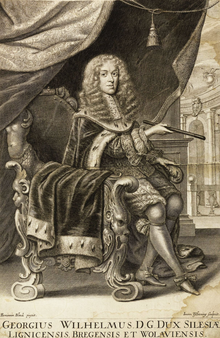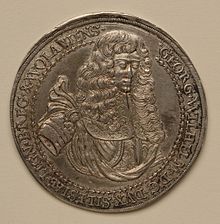George William, Duke of Liegnitz
George IV William | |
|---|---|
| Duke of Legnica | |
 Georgius Wilhelmus D.G. Dux Silesiae, engraving by Jan Tscherning (1650-1732) | |
| Born | 26 September 1660 Oława, Silesia |
| Died | 21 November 1675 (aged 15) Brzeg |
| Buried | Church of St. John in Legnica |
| Noble family | Silesian Piasts |
| Issue | Karolina of Legnica-Brieg |
| Father | Christian, Duke of Brieg |
| Mother | Louise of Anhalt-Dessau |
George William (Template:Lang-de), also known as George IV William ; Template:Lang-pl; 29 September 1660 – 21 November 1675) was the last Silesian duke of Legnica and Brzeg from 1672 until his death. He was the last male member of the Silesian Piast dynasty descending from Władysław II the Exile (1105–1159).
Family
George William was the eldest but only surviving son of Duke Christian of Legnica-Brzeg (1618-1672) by his wife Louise (1631-1680), a daughter of the Ascanian prince John Casimir of Anhalt-Dessau. He had three siblings:
- Karolina of Legnica-Brieg (1652-1707), last Silesian Piast duchess, married to Frederick, Duke of Schleswig-Holstein-Sonderburg-Wiesenburg (1651–1724) in 1672;
- Louise (1657–1660);
- Christian Louis (1664-1664).
As the only surviving son, George William was the sole heir to his father's possessions. Duke Christian of Legnica-Brzeg had spent many years in exile in Poland and in the Duchy of Prussia during the Thirty Years' War, after George William's grandfather Duke John Christian of Brieg had fallen out of favour with the Habsburg emperor Ferdinand II.
Duke Christian became sole ruler over the Silesian duchies of Legnica and Brzeg in 1664. After the abdication of King John II Casimir Vasa of Poland in 1668, he even put forward his own candidacy for the Polish throne; in order to win the affection and support of the old nobility, he initially wanted to give his newborn son an old Piast name (like Mieszko or Bolesław); however, the Calvinist clergy of his duchy opposed this, maintaining that the idea could bring the return to paganism over Poland. The duke, however, saw to it that his son spoke Polish and wore Polish clothes.
Life
The deaths in 1663 and 1664 of his paternal uncles Duke George III of Brzeg and Duke Louis IV of Legnica without surviving issue left him as the only heir of his father in the still vast Duchy of Legnica-Brzeg. As a result, since his early years, George William received a careful education. During his upbringing, he was put in the hands of the Anhalt-Bernburg count-marshal August Friedrich Bohne, and the personal doctor Henry Martini. It was during this first period of his education that he acquired an excellent knowledge of German, French and Latin, also understood Italian, Spanish and Polish; he was also educated in theology, philosophy and rhetoric.
When his father died in 1672, the then twelve-years-old George William succeeded him as Duke of Legnica and Brzeg; during his minority, the regency was exercised by his mother, Dowager Duchess Louise who held the towns of Wołów and Oława as her dower (wittum). Fearing claims raised by the Habsburg Emperor Leopold I in his capacity as ruler over the Crown of Bohemia, Duke Christian had devised by will that his son was formally under the tutelage of his maternal uncle Prince John George II of Anhalt-Dessau and the mighty Hohenzollern elector Frederick William of Brandenburg. The day before his father's death, Louise sent her son to study at the Viadrina University in Brandenburgian Frankfurt/Oder, considered as an act of mistrust by the Imperial court. On the other hand, the regency of the dowager duchess faced the opposition of the Protestant estates of Legnica-Brzeg, thanks to her increasingly open support for the Catholic faith; a major scandal occurred when the young duke's sister Karolina secretly married Frederick, a member of the aristocrat Catholic family of Schleswig-Holstein-Sonderburg-Wiesenburg.
The Brandenburg elector reached an understanding with the Habsburg emperor, and in 1673 George William returned to Brzeg, where he received the homage by the estates. On 14 March 1675 the young duke could take formal possession of the government of his lands, after he went to the Imperial court in Vienna making his solemn homage to Emperor Leopold I, who confirmed his coming of age and the succession to his father's lands. Immediately after the beginning of George William's personal rule, Duchess Louise was forced to give up her land of Wołów. The announcements of the start of a good and prosper government by George William were stopped with the sudden death of the duke on 21 November 1675. The cause of his death was a strong fever, developed shortly after his return from a hunt, the first sign of smallpox. The duke was buried in the church of St. John in Legnica, alongside his father, where his grieved mother had a mausoleum built.
Legacy

Upon his death, the Duchy of Legnica-Brzeg reverted to Emperor Leopold as ruler over the Bohemian crown lands, which since 1526 were integral part of the Austrian Habsburg Monarchy. Leopold took up the government by a Landeshauptmann deputy, despite the claims of George William's morganatic uncle Count August of Legnica, and had several Counter-Reformation measures implemented. Duchess Louise retained her lands of Oława until her death in 1680, when they were also incorporated into the Bohemian lands.
The independent Masovian Piasts had died out in 1526, while the Teschen (Cieszyn) line had become extinct in 1653. George William was therefore the last ruling member of all the Piast dynasty, which finally became extinct with the death of his only surviving sibling, Karolina, in 1707. The term "Piast dynasty" was first used by the Polish historian Adam Naruszewicz in his books History of Poland, which he started in 1779. On George William's burial crypt a text was carved referring to him as the last of the Piast dukes of Silesia, who are since the 17th century [1][2] referred to as "Silesian Piasts".
Ancestry
| Patrilineal descent |
|---|
|
Patrilineal descent, descent from father to son, is the principle behind membership in royal houses, as it can be traced back through the generations. George William, Duke of Liegnitz was the last legitimate male of the Piast dynasty. Descent before Mieszko I is partly fictional. This is the descent of the primary male heir.
|
References
- ^ Encyklopedia Powszechna PWN Warsaw 1975 vol. III page 505
- ^ : Encyclopædia Britannica: Piast Dynasty
External links
- Genealogical database by Herbert Stoyan
- Marek, Miroslav. "Complete Genealogy of the House of Piast: Silesia". Genealogy.EU.[self-published source][better source needed]
- Template:MLCC
